Introduction
The quality of beef and its products is a crucial factor in the success and sustainability of the beef industry. Beef quality encompasses various aspects, including appearance, physical characteristics, experience attributes and credence qualities (organic, animal welfare and food safety; Hoa et al., 2024; Lee et al., 2022). These elements are interconnected and collectively influence the overall eating quality of beef (Hoa et al., 2024; Holman and Hopkins, 2021). Unsurprisingly, the eating quality experienced by consumers significantly impacts their future beef purchase decisions (Santos et al., 2021).
The degree of marbling, which entails the presence of visible white flecks or streaks of intramuscular fat (IMF), is a pivotal factor affecting beef quality and palatability (Nguyen et al., 2021; Stewart et al., 2021a; Watson et al., 2008b). Marbling score influences the texture and lipid oxidation of red meat (Domínguez et al., 2019; Zhang et al., 2022). Moreover, higher marbling levels are positively associated with improved meat eating quality attributes including tenderness, flavour, juiciness, overall liking and palatability (Holman and Hopkins, 2021; Santos et al., 2021; Stewart et al., 2021b). However, the definition of palatability is not universal and consumer perspectives on meat quality are complex (Henchion et al., 2017; Holman and Hopkins, 2021). Both Polkinghorne et al. (2014) and Santos et al. (2021) stated that the beef preferences and expectations about sensory quality vary among cultures. According to Lee and Lopetcharat (2017), the knowledge about the factors influencing food acceptance and choices across various cultures, as well as identifying opportunities for successful product development that resonates globally across diverse cultures, is essential for thriving in increasingly varied and competitive markets.
Currently, the Meat Standards Australia (MSA) is probably the most reliable and advanced red meat grading scheme, which has been used in 13 countries (Meat & Livestock Australia [MLA], 2023) and widely recognised as the most established guarantee system for beef and sheep meat eating quality (Hocquette et al., 2018). Its testing protocol was designed specifically for the evaluation of overall sensory properties across the entire carcass (McGilchrist et al., 2019). In contrast, the meat quality score (MQ4) was developed for testing the potential sensory quality of specific muscle cuts (Liu et al., 2021). Sensory studies following the MSA protocol involve a large amount of untrained consumers and adhere to strict guidelines for meat sampling, cooking, and serving, along with complex randomisation of carcasses, sides, cuts, primal, and consumer groups (Ha et al., 2019). According to Polkinghorne et al. (2014), the palatability scores of beef products evaluated using the MSA system might differ in various countries. In particular, Japanese consumers consistently assigned lower ratings to all MSA sensory scores compared to Australian counterparts (Ha et al., 2019). Thus, understanding consumer preferences, such as preferred meat cuts, cooking methods, and desired levels of doneness, in target export markets offers a valuable opportunity to optimise beef product values.
The Middle East region is the fastest growing export market of Australian beef over the past decade, and Saudi Arabia and the United Arab Emirates (UAE) have continuously ranked within the top 20 most valuable export destinations for Australian beef (MLA, 2022). The consumer preferences for marbling levels and cooking methods vary across different countries (Liu et al., 2021). According to MLA (2022), the Middle Eastern consumers primarily consume lean domestic beef, and traditional local dishes often involve slow cooking, both wet and dry, accompanied by heavy spicing. Meanwhile, the MSA recommended cooking methods, including grill, roast, shabu shabu (a Japanese style hotpot) and yakiniku (a Japanese style grill) might not be familiar with Middle Eastern consumers. This raises the question of how Middle Eastern consumers perceive premium beef, particularly when compared to domestic Australian consumers, when the meat is prepared using grilling methods. Consequently, it is crucial to evaluate the sensory responses of consumers in export markets and to assess the accuracy of the MSA prediction model in aligning with their expectations. The objective of the present study was to examine variations in eating quality evaluations of premium Australian beef between the domestic and Middle Eastern consumers to expand the knowledge and perception of international consumers for premium Australian beef.
Materials and Methods
Consumer sensory tests were carried out in New South Wales, Australia and Dubai, the UAE. The wellbeing of all participants was ensured in accordance with the use of the MSA protocol for sensory evaluation of beef and lamb meat samples. The Human Research Ethics Committees of the University of New England granted approval for all procedures (approval number: HE17-253).
A large cohort of 200 animals, including two breeds: purebred Angus (AA) and Wagyu×Angus cross (WA) cattle, were sourced from of a hormone- and antibiotic-free feedlot. Prior to processing at a commercial abattoir in Queensland, Australia, a group of cattle had been collectively fed for approximately 200 days in the same pen. On the processing day, a total of 36 carcasses were chosen, consisting of 18 AA and 18 WA. These were selected in pairs as cases and controls, with efforts made to match the marbling and ossification levels as closely as possible between the AA and WA carcasses. Subsequently, an MSA-trained assessor graded the carcasses according to the AUS-Meat chiller assessment standards and the MSA grading system (AUS-MEAT, 2005). The carcass traits of investigated cattle are presented in Table 1.
In accordance with the Australian standard practice, carcass grading and boning took place about 16–24 hours post-mortem (Holman et al., 2019). The bolar blade, D-rump, outside flat and striploin were obtained from the left side of each carcass. Each primal was individually sealed into vacuum bags, chilled at 2°C and then transported to the Meat Science laboratory, the University of New England, Armidale, Australia for further processing and measurements.
After seven days post-mortem, the primal were stripped of external fat, sinew, and epimysium. Subsequently, they were dissected into individual muscles with bolar blade divided into M. triceps brachii caput longum (BLD096), outside flat into M. biceps femoris (OUT005), D-rump into rump cap or M. biceps femoris (RMP005), eye rump centre or M. gluteus medius (RMP131), and eye rump side or M. gluteus medius (RMP231), and striploin into M. longissimus lumborum (STR045).
The sensory (grill) samples of each muscle were prepared following the MSA protocol, which was documented by Watson et al. (2008a). In brief, the individual muscles were portioned into consumer samples with each sample comprised of 5 individual steaks each approximately 75×40×25 mm. Each individual steak was wrapped in freezer film with the set of 5 placed in a uniquely labelled bag and vacuum-packed. Subsequently, all samples were aged at a temperature of 2°C until reaching 14 days post-slaughter. They were then frozen and stored at approximately –20°C until thawed for sensory testing. Paired samples were prepared from each muscle with position rotated to ensure balanced allocation to the Middle East and Australia.
Four sample cartons (1,260 meat samples including 180 linked samples) remained in Australia, while the corresponding amount of meat samples was shipped to the UAE from an Australian processor with export licensing. In both countries, meat eating evaluations were conducted using identical MSA protocol to ensure uniform testing. The questionnaire and scoring sheets were the same in both countries, with the only difference being that they were translated from English to Arabic for the Middle Eastern consumers. After translation, these questionnaires were tested by independent Middle Eastern groups and underwent multiple adjustments to ensure that they conveyed the identical meaning in both languages.
Briefly, meat samples were defrosted at 4°C for 24 hours, then grilled on a Silex Clamshell Grill (Silex Elektrogeräte, Hamburg, Germany) set at 210°C for the bottom and 195°C for the top cast iron plate. For each cooking round, ten sample steaks were prepared. The steaks were cooked till reaching a “medium” degree of doneness (68°C), then rested for 3 minutes at room temperature. Subsequently, each steak was halved into two equal-sized rectangular pieces and served to two separate consumers. In each country, a total of 360 adults, who usually consume beef at least once a week, was recruited to participate in six sensory tests. Each sensory test consisted of three groups of 20 untrained consumers with each 60 consumers evaluating a total of 42 samples. Each sample was evaluated by 10 different participants, with each consumer evaluating 7 samples. The initial sample (link sample), selected as an assumed mid-range eating quality, was served as a standard reference for all participants. The following 6 test products were selected to represent expected different eating quality related to the different breed types and muscles with each consumer served one sample from each product to ensure range. The order of serving for each consumer was controlled by a 6×6 Latin Square design, ensuring that each product was tasted in equal proportion before and after each other product and equally in serving orders 2 to 7. This protocol balanced out potential halo and order of serving effects. Consumers were instructed to use a 100 mm line scale to grade each sample based on tenderness (0 indicating not tender and 100 indicating very tender), juiciness (0 indicating not juicy and 100 indicating very juicy), flavour (0 indicating extreme dislike and 100 indicating extreme liking), and overall liking (0 indicating extreme dislike and 100 indicating extreme liking). Individual sensory scores provided by consumers were weighted as follows: 0.3 for tenderness, 0.1 for juiciness, 0.3 for flavour, and 0.3 for overall liking. These weighted scores were utilised to compute a MQ4 (Watson et al., 2008a).
Prior to computing the mean sensory scores for each sample, the 10 individual scores for each sample were arranged in rank order (from highest to lowest), and the two highest and two lowest scores were disregarded to mitigate the variability of the mean sensory scores. Initially, the data were evaluated for normality assumptions using histograms and plotting residuals. Statistical analyses were conducted in R (R Core Team, 2021). Consumer sensory scores were subjected to analysis using a linear mixed-effects model implemented in the “lme4” package (Bates et al., 2019). The “emmeans” package (Length, 2021) was employed to calculate estimated marginal means. Country, muscle type, breed and their interactions were incorporated in the models as fixed effects. The models were refined systematically to eliminate irrelevant and insignificant interactions. Furthermore, the analysis included individual carcass identification as a random effect. Least square mean values and SEM are presented. The Tukey test was used to assess the statistical significance of differences, with a significance threshold set at p<0.05. p-values between 0.05 and 0.10 were interpreted as indicating a trend.
Results
The hot standard carcass weight (HSCW) was significantly higher in the AA steers, with a difference of 12.7 kg compared to the WA steers (p<0.05, Table 1). The ultimate pH of the WA steers (5.50) was significantly higher (p<0.05) than that of the AA steers (5.47). No marked difference was observed in eye muscle area and rib fat depth between the two breeds (p>0.05). Hump height is used to validate the declared tropical breed content and to ascertain the most accurate eating quality results in conjunction with HSCW and gender. Generally, increased hump height leads to decreases in eating quality of the carcasses. It is measured by positioning a ruler parallel to the surface of the sawn chine, perpendicular to the first thoracic vertebra, and then adjusting the ruler to align with the point of maximum hump width. Table 1 shows that the hump height of the carcasses was not significantly different between the two groups. Especially, there were similarities in ossification or marbling scores between the AA and WA steers.
The influences of country, breed and muscle type on the tenderness of experimental steaks are presented in Table 2 and Fig. 1. Muscle type was the primary determinant of tenderness scores for the grilled samples (p<0.001). The RMP005 muscle recorded the highest tenderness score (74.7). In contrast, the OUT005 muscle had the lowest tenderness score (41.9) and was significantly less tender compared to all other muscle types (p<0.001). The tenderness scores were substantially influenced by cattle breed (p=0.011), with AA scoring 58.5 compared to 63.0 from WA (Table 2).
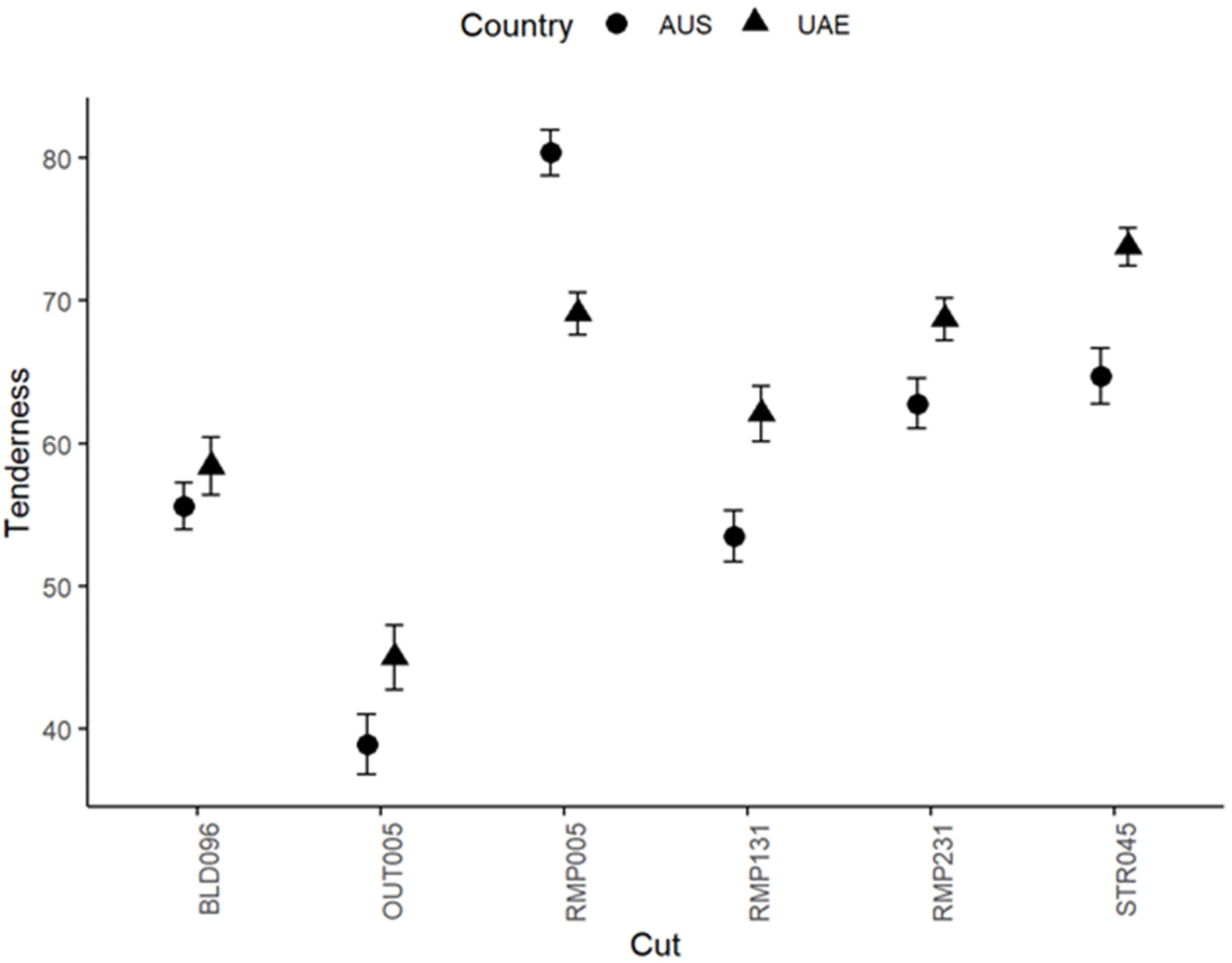
Although tenderness scores of beef were similar in both countries (p>0.05), there were some significant interactions between country and muscle type (p=0.032). The Australian consumers scored the RMP005 muscle higher for tenderness than the Middle Eastern consumers, whereas they rated the OUT005, RMP131, RMP231 and STR045 muscles lower than their UAE counterparts. Nevertheless, tenderness for the BLD096 muscles did not considerably differ between the two countries. (p>0.05; Fig. 1). Other significant interactions among country, breed and muscle type were not observed (p>0.05).
There was a significant effect of muscle types on juiciness (p<0.001; Table 2). Particularly, the RMP005 muscle had considerably higher juiciness scores (74.9) than the other muscle types. The juiciness scores of STR045 were remarkably higher than those of RMP131 and OUT005 muscles. Furthermore, the OUT005 muscle recorded the lowest juiciness scores (55.0).
No country or breed effects on beef juiciness were observed (p>0.05), while there were significant interactions between muscle type and country on juiciness scores (p=0.048). Particularly, consumers from the Middle East rated the RMP005 muscle significantly lower, yet gave higher ratings to the RMP131, RMP231, and STR045 muscles compared to Australian consumers. Nonetheless, no differences in juiciness scores between the two countries for OUT005 and BLD096 were observed (Fig. 2). The other interaction effects on juiciness scores were insignificant.
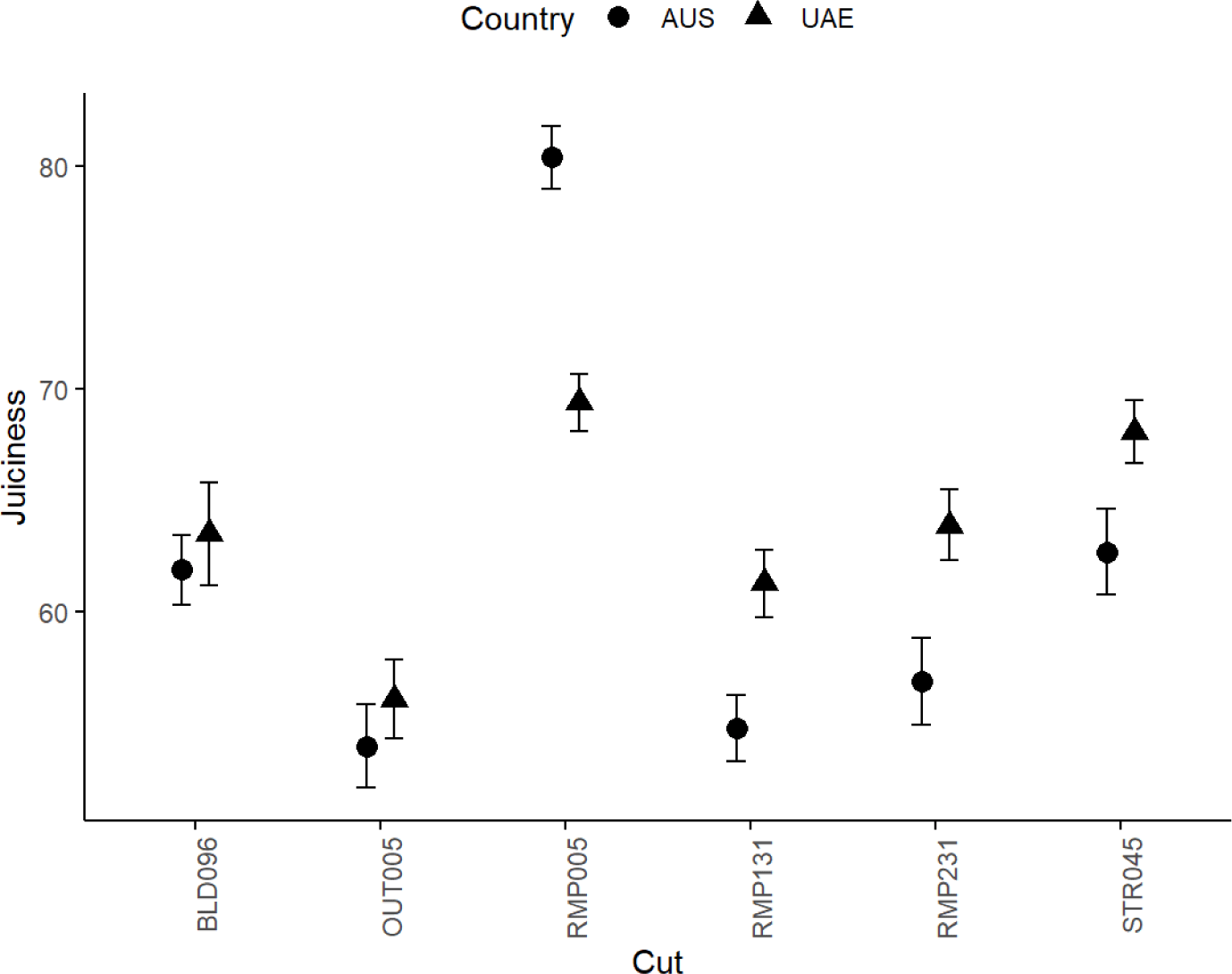
The effects of country, breed, muscle type and their interactions are displayed in Table 2 and Fig. 3. Country and breed had no substantial impact on flavour (p>0.05), while muscle type considerably influenced the flavour scores of the steers (p<0.001). The lowest flavour score (53.4) was observed in the OUT005 muscle, while the RMP005 and STR045 muscles recorded the highest scores (72.8 and 69.4, respectively). No significant difference in flavour among the BLD096, RMP131 and RMP231 muscles (p>0.05).
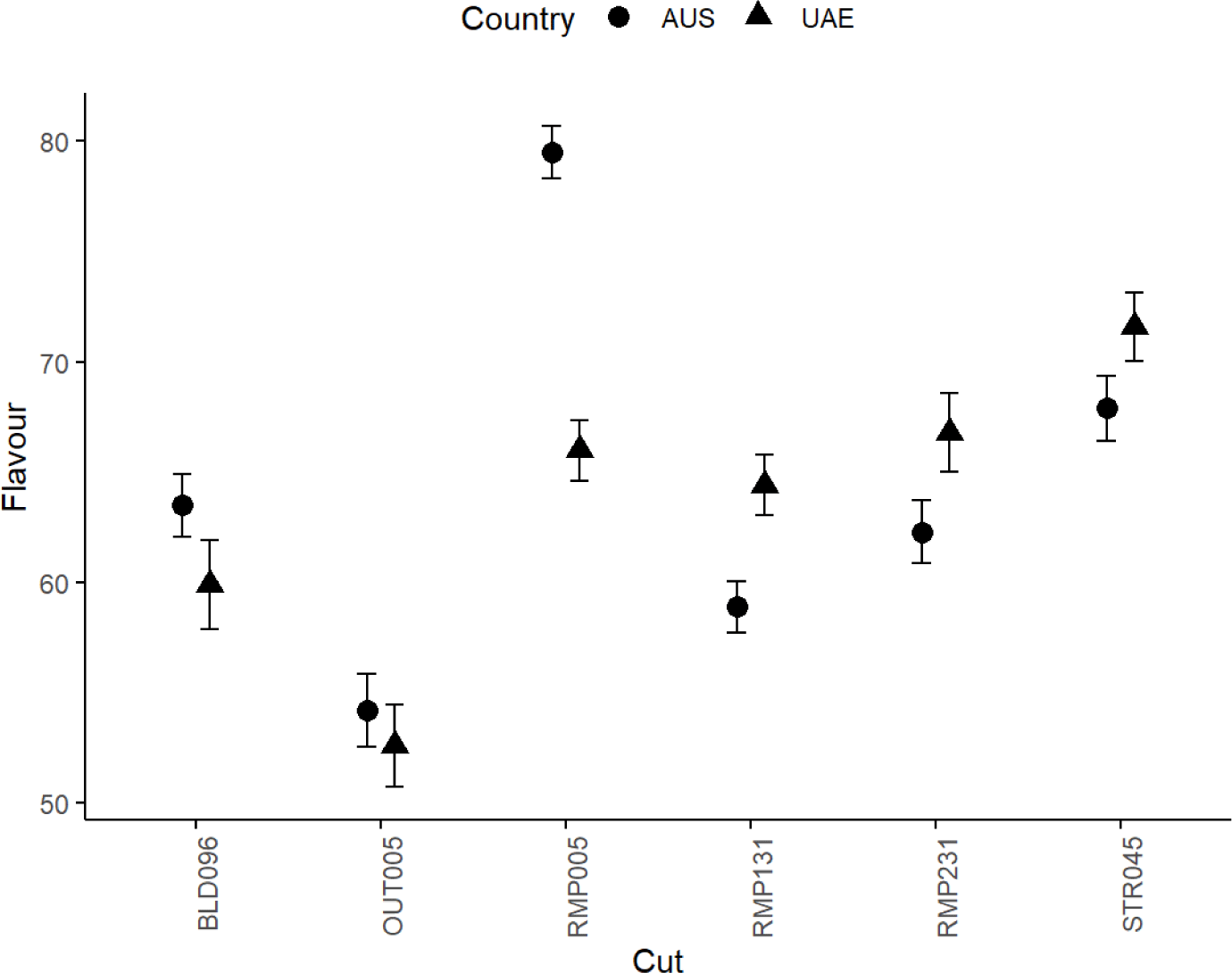
Interactions between country and muscle type for flavour were significant (p=0.021, Fig. 3). Specifically, consumers from the UAE rated the flavour of the BLD096 and RMP005 muscles significantly lower than Australian consumers. In contrast, the flavour of RMP131, RMP231 and STR045 muscles rated by Middle Eastern consumers were significantly higher than those scored by Australian consumers. No substantial difference in flavour scores between the two countries for OUT005 was observed (p>0.05).
Muscle type significantly affected the overall liking (p<0.001; Table 2). The overall liking score of OUT005 muscle (50.9) was considerably lower than other measured muscle types, whereas the highest overall liking score (74.7) was observed in the RMP005 muscle. The overall liking score of RMP231 had no considerable differences compared to that of STR045, RMP131 and BLD096 muscles (p>0.05). There was a tendency for breed to influence overall liking (p=0.074), while no remarkable difference in overall liking between the two countries.
There were significant interactions between muscle type and country on overall liking (p=0.009; Fig. 4). The Middle Eastern consumers rated their overall liking of the RMP005 lower compared to Australian consumers, but they gave higher overall liking scores to the OUT005, RMP131, RMP231, and STR045 muscles than their Australian counterparts. However, no considerable difference in the overall liking of BLD096 muscle between Australia and the UAE was detected (p>0.05).
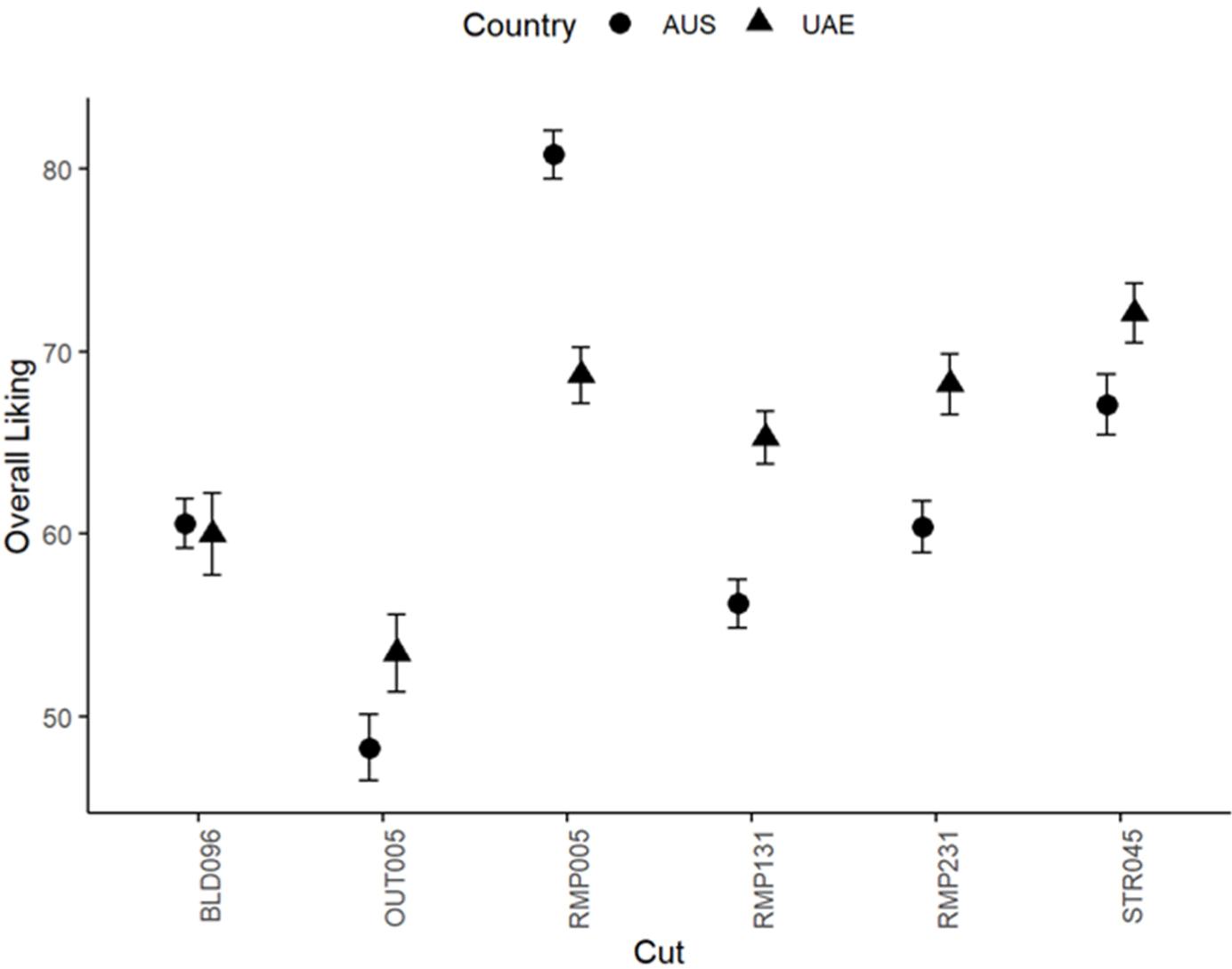
The effects of country, breed, muscle type and their interactions in the MQ4 scores of grilled beef by are illustrated in Table 2 and Fig. 5. Muscle type was the main driver of MQ4 score for the grilled beef in this study (p<0.001). Specifically, the OUT005 muscle recorded the lowest MQ4 score (49.4), while the highest MQ4 score (73.6) was observed in the RMP005 muscle. There was a similarity in the MQ4 score among the BLD096, RMP231 and STR045 muscles. The MQ4 scores were not influenced by breed and country.
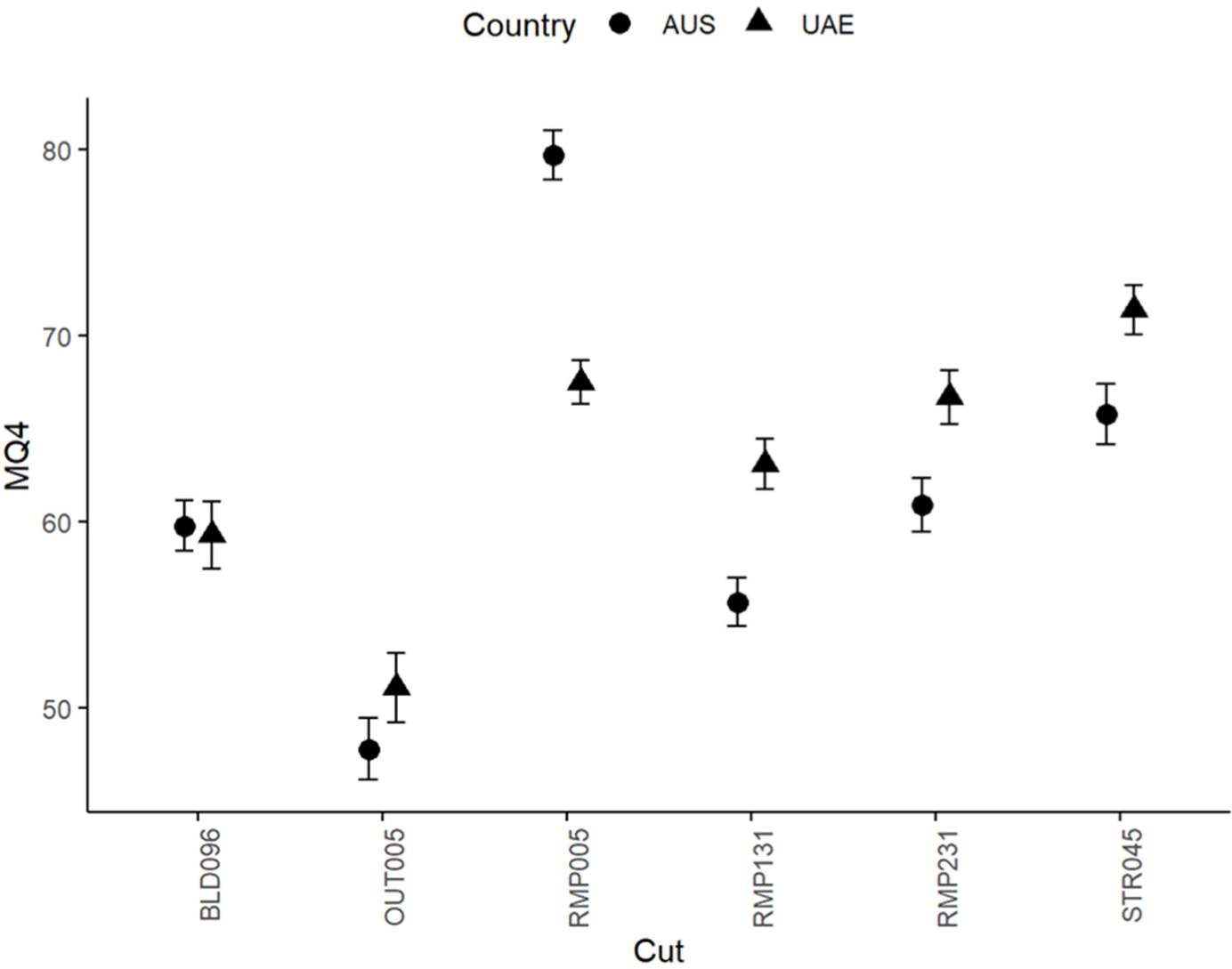
The country and muscle type interaction considerably affected the MQ4 score (p=0.014). Particularly, the Middle Eastern consumers graded the MQ4 of RMP005 lower than Australian consumers. In contrast, the MQ4 scores of RMP131, RMP231 and STR045 muscles rated by the Middle Eastern consumers were higher than those scored by the Australian consumers. Between the two countries, the MQ4 of the BLD096 and OUT005 muscles was not significantly differ (Fig. 5). Other significant interactions on MQ4 scores were not observed.
Discussion
The data in this study indicated that both the Middle Eastern and Australian consumers were relatively consistent in sensory scores, but substantial differences influenced by interactions between country and muscle types was detected in all of the eat quality traits. Our results are consistent with the findings of Polkinghorne et al. (2014), who used the MSA system to compare the sensory perception of the four different muscle types of Australian beef assessed by Japanese and Australian consumers. They explained that the slight variation in the sensory attributes between the two countries might be due to the Japanese consumers’ relative unfamiliarity with eating a thick grilled steak (25 mm), not the beef itself. When thinner steaks (12.5 mm) were used, the results were indistinguishable. Similarly, Thompson et al. (2008) stated that despite the tendency of Korean consumers to assign lower sensory scores to beef samples compared to Australian counterparts, the results indicated minimal disparity in the sensory scores provided by the two consumer groups. When conducting MSA sensory tests in the longissimus lumborum muscle (STR045) in Japan and Australia, Ha et al. (2019) reported that a substantial disparity in eating quality scores was detected. The results from the STR045 muscle in the present study also found the disparities in the tenderness and juiciness scores assessed by Middle Eastern and Australian consumers. However, one muscle type is not able to represent the whole carcass, suggesting the necessity for conducting similar tests utilising various muscle types of beef cattle. In accordance with previous studies reported by Legrand et al. (2013), Polkinghorne et al. (2014) and Thompson et al. (2008), our findings reaffirm that the MSA grading system with some adjustments to the preferences of cooking method and muscle type would be possible to comparatively describe the eating quality of Australian beef products assessed by international consumers as there is a high level of agreement and consistency among the consumers.
In the present study, breed was not a significant indicator for the variations in measured sensory parameters with the exception of tenderness. Nguyen et al. (2021) and Stewart et al. (2021a) agreed that the sensory quality including tenderness, juiciness and overall liking had a significant positive relationship with the level of marbling which is collaboratively influenced by nutritional, sexual, genetic and management factors. Many studies also found that differences in sensory attributes among beef breeds could be caused by variations in marbling levels and total collagen contents (Conanec et al., 2021; Frank et al., 2016; Gagaoua et al., 2016). Nevertheless, both Conanec et al. (2021) and Santos et al. (2021) stated that cattle breed plays an important role in the IMF content and fatty acid profile of beef but in a lower extent than nutrition.
It has been proven that there is no discernible distinction in sensory scores or consumer acceptability between beef and dairy breeds when they are raised under comparable conditions (Bonny et al., 2016; Conanec et al., 2021; Lizaso et al., 2011). Moreover, beef flavour and juiciness were not significantly influenced by breed (Campo et al., 1999). Chambaz et al. (2003) also concluded that when the marbling levels are equivalent across various breeds such as Angus, Charolais, Limousin, and Simmental, the flavour would be similar. In the current study, the steers were from one feedlot facility with the same age, nutritional regime and finishing period. In addition, the carcasses from the two breeds were selected matched as close on marbling and ossification levels as possible (Table 1). Therefore, the marbling level of the carcasses were similar although they came from purebred Angus and crossed Wagyu×Angus. These could explain the similarity in almost beef sensory attributes between the two breeds in the present study.
The disparity in tenderness score between the two breeds in this study aligns with the findings of Chambaz et al. (2003), who found that Limousin and Angus yielded meat with greater tenderness compared to Simmental and Charolais when sensorial testing meat from these four breeds with the similar marbling level in the longissimus dorsi muscle. This highlights the significance of breed in determining tenderness, even when considering factors such as marbling content. Hocquette et al. (2006) stated that various cattle breeds or genotypes exhibit differences in their muscle characteristics owing to significant distinctions in animal physiology.
Overall, the influence of genetics and nutrition on sensory attributes appeared to be less pronounced compared to the effects of muscle type. The impacts of muscle on sensory traits were remarkably consistent, typically observed across all breeds and diets (Wood et al., 2004; Wood et al., 2008). Unsurprisingly, those findings align with our results. It has been agreed that variations in intrinsic muscle characteristics including fibre, IMF and connective tissue contents among muscle types are involved in beef sensory quality disparities (Arshad et al., 2018; Chriki et al., 2013; Li et al., 2023). According to Dubost et al. (2013), IMF contents within the muscle are positively correlated with beef tenderness, juiciness and flavour. They also noted that the cross-sectional area or diameter of muscle fibres seemed to impact tenderness from the very early post-mortem period up to six days of aging. After 14 days of ageing, the characteristics of connective tissue, including quantity, structure and composition, play a significant role in determining a substantial portion of beef toughness and variations in meat quality (Dubost et al., 2013). Muscle connective tissue comprises collagen fibres embedded within a matrix of proteoglycans (Listrat et al., 2016). The amount of collagen can affect tenderness, but it can sometimes lead to inconsistent conclusions (Chriki et al., 2013; Roy and Bruce, 2023). Certainly, high positive correlations between total collagen content and shear force are observed in raw meat whereas only low correlations are detected in cooked meat (Dubost et al., 2013; Roy and Bruce, 2023).
The lowest sensory scores of the biceps femoris muscle (OUT005) compared to the other muscles in this study aligns with the findings of Dubost et al. (2013) and Sifre et al. (2005) who concluded that the biceps femoris muscle was tougher than the longissimus thoracis muscle. This finding may be attributed to the substantially higher total collagen content in the outside flat compared to the striploin (Jeremiah et al., 2003). Dashdorj et al. (2017) also found that total collagen content of biceps femoris muscle was more than twice compared to that of the longissimus lumborum and longissimus thoracis muscles. Collagen affects meat tenderness variations by creating a connective tissue matrix that becomes more thermally stable and less soluble as it ages (Roy and Bruce, 2023). This stable connective tissue matrix makes the meat more difficult to chew and results in lower tenderness scores (Weston et al., 2002). The strong association between tenderness and other sensory attributes likely led to the OUT005 muscle having lower scores compared to the other muscles for all sensory properties (Polkinghorne et al., 2011). Another possible explanation for marked variations in sensory attributes among muscles is the difference in their IMF contents. In particular, Yang et al. (2019) indicated that the IMF content of biceps femoris muscle in Hanwoo cattle (7.8%) was much lower that of longissimus lumborum muscle (26.3%). A surprising finding from the present study was the exceptionally high scores for the rump cap (RMP005). It seems that in carcasses with higher IMF, the rump cap delivers outstanding sensory properties. According to Arshad et al. (2018) and Listrat et al. (2016), meat juiciness and flavour in sheep and cattle positively correlates with an increased proportion of postural slow oxidative (type I) fibres. This can be attributed to the elevated levels of phospholipids in type I fibres, as these compounds play a crucial role in determining the flavour of cooked meat (Listrat et al., 2016). Nonetheless, it is still uncertain how the prevalent fibre types within a muscle impact cooked beef flavour. Variances among these muscle fibre types encompass various factors, such as enzyme and mitochondrial properties, antioxidant capacity, total lipid content, levels of free ionic iron and total heme protein, and fatty acid profile (Li et al., 2023). Furthermore, Thompson et al. (2008) stated that variations in consumer attitudes towards beef quality across different countries may be taken into account for importers. In particular, countries exporting beef products to the Middle East should be aware that rump cap were significantly upgraded in meat quality score by the Middle Eastern consumers.
Conclusion
Muscle type is a major determinant of the meat quality score. The rump cap consistently scored higher for tenderness, juiciness, overall liking and MQ4 scores compared to the other muscle types, whereas the lowest scores of all sensory attributes were detected in the outside flat muscle. The Middle Eastern consumers had similar appreciation of grilled beef samples to Australian consumers. Breed significantly influenced beef tenderness, but not the other sensory quality traits. The interactions between muscle type and country influenced all of the sensory properties. The RMP005 muscle demonstrated the most notable disparities in both countries. The findings reaffirm the applicability of the MSA model for Middle Eastern consumers while also highlighting areas for refinement, particularly for certain muscle types like the rump cap, which exhibited superior eating quality. Additionally, this study provides valuable insights into the preferences of Middle Eastern consumers regarding premium Australian beef. However, further adjustments may be required to more accurately reflect Middle Eastern consumer perceptions.













